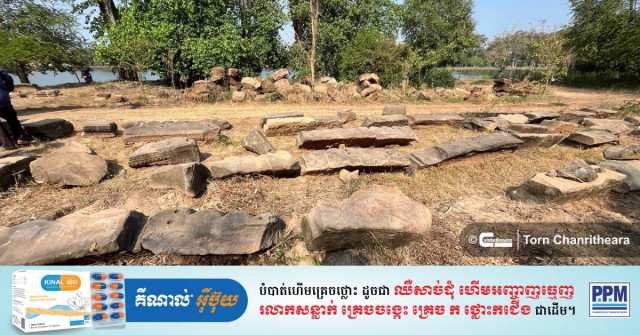Solving the Stone Puzzle of Angkor Wat

- By Torn Chanritheara
- March 9, 2024 11:30 AM
SIEM REAP – Under the scorching dry season sun, an APSARA Authority restoration team led by archaeologist Orn Sopheap is reassembling stones scattered next to the wall north of the western entrance of Angkor Wat before putting them in their original place.
For weeks, the team has moved and recorded the stones believed to be parts of the gallery and the top tier of the three towers of the entrance which is a popular gateway to the temple.
The stones were moved to their current location by a French team before 1949, project leader Sopheap said.
He said the team had registered the 1,656 stones using a grid system and grouped them according to whether they were part of the roof, top tier, pillar or the gallery’s structure.
“The French moved them to their current place from where they had fallen down. There are also stones on the south side of the entrance and inner side of the wall,” he said.
 The stones were moved to their current location by a French team before 1949. Photo: Torn Chanritheara
The stones were moved to their current location by a French team before 1949. Photo: Torn Chanritheara
Sopheap said the project is to locate the original places of those stones and work out the percentages that can be reassembled.
The 1,656 stones include lion statue fragments, pieces of statues and stones of other structures.
The archaeologist said that most of the stones are part of roof of the gallery of the temple’s west entrance which had collapsed.
“Some belong to the top level of the entrance’s towers because they have a round lotus petal style,” he said.
These stones, some of which could weigh hundreds of kilograms, are being reassembled with the help of a truck-mounted crane and some have been successfully matched.
Whether the stones will be put back in their original places depends on the extent to which they are matched.
“We can’t do it unless we can find up to 70 percent,” he said.
 This photo shows project leader Orn Sopheap at restoration site. Photo: Torn Chanritheara
This photo shows project leader Orn Sopheap at restoration site. Photo: Torn Chanritheara
Sopheap said the restoration should follow specific guidelines, particularly not using more than 30 percent of new stone. If they could identify only 20 to 30 percent, it might not be possible to put them in their original place and instead, they could be exhibited at other places.
Despite the number of stones scattered along the wall, he said that some might be missing or have been moved from the temple for restorations at other sites.
For instance, the towers of the entrance had up to five tiers which require as many as 50 stones per tier.
Eye and hand as tool for reassembly
While a crane is needed to move larger stones, the restoration team use their eyes and hands, combined with long experience, to put them in place together without being assisted by any computer program.
“We use observation. Stone temples have structures such as knuckle, seam and art. We use our eyes to observe those things,” Sopheap said.
 Assisted by truck-mounted crane, the workers are able to move heavy stones. Photo: Torn Chanritheara
Assisted by truck-mounted crane, the workers are able to move heavy stones. Photo: Torn Chanritheara
Experience plays a big role in restoring the temple as each stone had been carved to install at specific place, making it easier for the team to locate their places.
Built during the reign of King Suryavarman II, Angkor Wat represents the Khmer civilization and architecture legacy. Many parts of the temple, however, have deteriorated severely over time.
The temple, which is part of Angkor Archaeological Park inscribed in UNESCO’s World Heritage List in 1992, is seeing many restorations at the site.
On the eastern entrance, a team is also restoring the gate’s roof where the stones have broken and collapsed.
 This photo shows a gallery on the northern part of the western entrance of Angkor Wat temple. Photo: Torn Chanritheara
This photo shows a gallery on the northern part of the western entrance of Angkor Wat temple. Photo: Torn Chanritheara
 The stones are scattered at the northern part of Angkor Wat's western entrance. Photo: Torn Chanritheara
The stones are scattered at the northern part of Angkor Wat's western entrance. Photo: Torn Chanritheara
Sem Vanna contributed to the story















